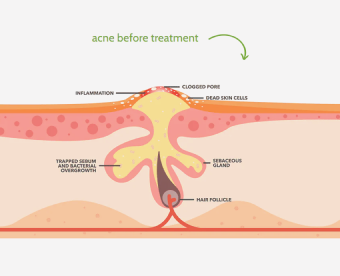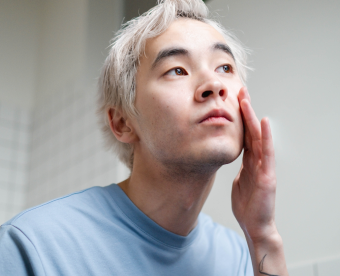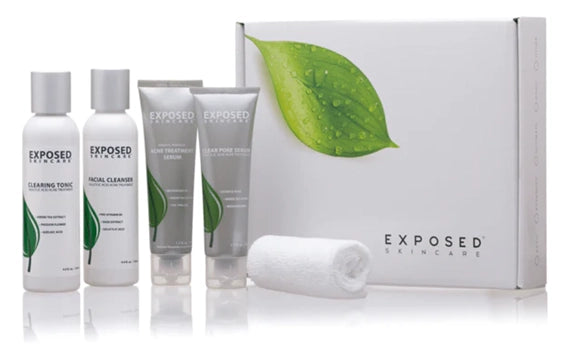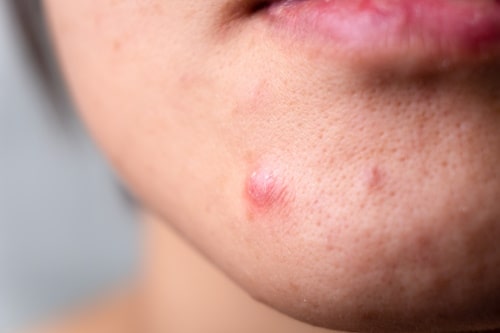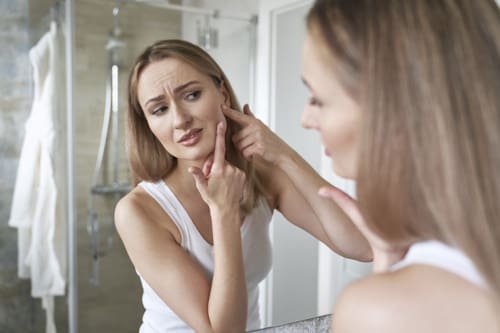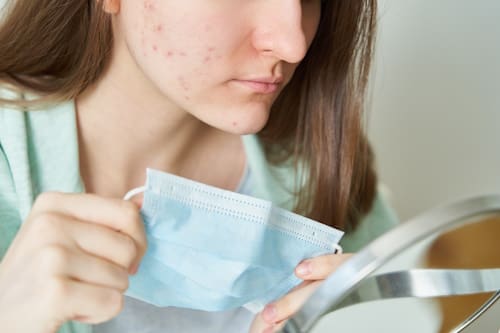One of the more uncomfortable and less discussed forms of acne is cystic acne in the groin area. This article will delve deep into what causes this type of acne, its connection to Hidradenitis Suppurativa (HS), and the various treatment options available.
Not only can the symptoms be physically painful, but they can also affect your quality of life. Thus, knowing how to manage this condition is crucial. Read on to learn more.
Also read: How to choose the best acne treatment
Biggest Take-Aways:
- Managing cystic acne in the groin area requires a comprehensive understanding of symptoms and causes.
- Early diagnosis is crucial for effective treatment, mainly because, if untreated, cystic acne can worsen around sensitive areas.
- A blend of medical treatments and specialized skincare products is often the most effective way to manage these complex skin conditions.
- Exposed Skin Care provides a comprehensive treatment solution that can be used alongside medical treatments to improve overall skin health.

What is Cystic Acne in the Groin Area?
Cystic acne in the groin area is not just your average pimple or minor breakout; it is a more severe form of acne that forms deep within the skin. These can be large, red, and filled with pus, causing significant discomfort.
But what makes it different from acne on the face or back? Let's explore this lesser-known skin condition and how it's closely related to a disease called Hidradenitis Suppurativa.
Relationship with Hidradenitis Suppurativa (HS)
Hidradenitis Suppurativa is a chronic skin disease that causes painful lumps under the skin, typically around hair follicles. Often, the areas of the body most likely to develop HS are those where skin rubs together, such as the armpits, buttocks, and groin area. While the exact cause of hidradenitis suppurativa is unknown, it often accompanies cystic acne in the groin area.
Signs and Symptoms of Groin Cystic Acne
- Lump or boil-like cysts in the groin area
- Pain or irritation, especially when walking or during physical activity
- Pus, blood, or a mixture of both exuding from the cyst
- Scarring on the skin after the cyst heals
What Causes Cystic Acne in the Groin Area?
Understanding what triggers cystic acne in the groin area is the first step in managing it effectively. Some causes may be similar to regular acne, while others could be unique to this form of acne.
Metabolic Syndrome and Other Health Conditions
People with metabolic syndrome or hormonal imbalances may be more prone to developing acne, including in the groin area.
Metabolic syndrome is a cluster of conditions that include high blood pressure, high blood sugar, and abnormal cholesterol levels, and it has been cited in various publications from the United States as being linked to skin conditions like acne.

Blocked Hair Follicles
Blocked hair follicles are one of the most common causes of acne and, in severe cases, can result in cystic acne in the groin area. When hair follicles become clogged with dead skin cells and sebum, it creates a conducive environment for bacterial growth, eventually leading to acne.
Poor Hygiene
Poor hygiene can exacerbate the situation, but it's important to note that it's not the sole cause. Failing to keep the groin area clean can worsen the condition for those who already have acne or are prone to it.
Treating Cystic Acne and HS in the Groin Area
Though there is no absolute cure for hidradenitis suppurativa or cystic acne in the groin area, various treatment options exist to manage symptoms and improve your quality of life. Before diving into treatments, diagnosing hidradenitis suppurativa or cystic acne is crucial to developing an effective treatment plan.
Antibiotic Treatments
For less severe cases, antibiotics may be prescribed to combat bacterial infection. This could be in the form of topical creams or oral medication. The antibiotic treatment options often aim to manage the pus and abscess formation.

Surgical Procedures
Surgical options may be considered for more severe instances where the acne forms deep cysts and abscesses that do not respond to antibiotics. This may include drainage or excision of large cysts or abscesses.
Laser Hair Removal
Laser hair removal is often suggested as a preventive measure. By reducing the amount of hair in the affected area, you decrease the likelihood of hair follicles becoming clogged, thus reducing the chance of a breakout.
Lifestyle Changes for Managing Cystic Acne in the Groin Area
Treatment options are essential, but lifestyle changes can significantly impact how you manage cystic acne in the groin area. Even small adjustments can make a big difference.
- Improve Hygiene Practices: Though poor hygiene alone doesn't cause acne, it can worsen existing conditions. Regular cleaning of the groin area can help manage symptoms and reduce the chances of flare-ups.
- Choose the Right Clothing: Tight-fitting clothing can exacerbate symptoms by causing friction in the groin area. Opt for loose, breathable fabrics like cotton to allow the skin to breathe.
- Diet and Exercise: Maintaining a healthy weight and diet can alleviate symptoms, particularly for those with metabolic syndrome. Exercise can improve blood flow and reduce inflammation, both of which are beneficial for managing hidradenitis suppurativa and cystic acne in the groin area.
- Stress Management: Stress can trigger flare-ups or make existing conditions worse. Engaging in stress-relieving activities can be a crucial part of your treatment regimen.

Misconceptions and Myths
Several misconceptions persist surrounding cystic acne in the groin area. Addressing these can help in better understanding and managing the condition.
- It is Contagious: Cystic acne and hidradenitis suppurativa are not contagious, unlike some skin conditions. You cannot catch it from someone else or pass it on.
- Only Poor Hygiene Causes It: While hygiene can contribute, it is not the sole cause. Hormonal imbalances, blocked hair follicles, and other health conditions can also be responsible.
- It Will Go Away On Its Own: Cystic acne and hidradenitis suppurativa can persist for many years and are often chronic. Management and treatment are usually necessary for relief from symptoms.
The Advantages of Using Exposed Skin Care for Acne Management
People with cystic acne around the groin area and the surrounding skin know that treating these conditions can be complex. Exposed Skin Care offers an array of benefits in treating this persistent issue.
Here's how Exposed Skin Care can benefit you:
- Comprehensive Treatment: Exposed Skin Care's range of products can manage various skin conditions, not just acne. People with HS also find it effective in treating hidradenitis suppurativa symptoms.
- Focused on Overall Skin Health: The products are crafted to treat acne and the painful bumps on your skin and improve overall skin health.
- Natural Extracts: Exposed Skin Care uses a blend of scientific ingredients and natural extracts to improve skin conditions like HS, which occurs near hair follicles and can even extend to areas like the inner thigh.
- Prevents Further Complications: By efficiently treating acne, it prevents conditions that may make your symptoms worse. It's particularly beneficial if your acne develops around sensitive areas like the groin.
Incorporating Exposed Skin Care into your routine could improve symptoms of hidradenitis suppurativa with treatment, thereby elevating your overall well-being.
Conclusion
Managing cystic acne in the groin area can be arduous, particularly if it develops around sensitive areas like the armpits and groin. It can severely affect your quality of life and often starts during the tumultuous years of puberty.
Understanding the symptoms and causes of these skin conditions is the first step toward effective management. While lifestyle changes and understanding the causes and risk factors are vital, choosing the right products for skin management is equally important. It's crucial to opt for treatments targeting visible symptoms and addressing underlying issues.
Exposed Skin Care offers products that treat various skin issues beyond just acne.It offers a range of products that can complement other medical treatments your healthcare provider prescribes.
So, whether it's cystic acne in the groin area or a more complex condition like hidradenitis suppurativa, comprehensive treatment plans that combine medical advice with effective skincare can make a significant difference. When dealing with persistent and often painful symptoms, understanding the complete picture is key to managing your condition effectively.
FAQs
Q: What is cystic acne in the groin area?
A: Cystic acne in the groin area is a severe form of acne that forms deep lumps and pus-filled cysts.
Q: What are the common symptoms and causes of hidradenitis suppurativa?
A: Symptoms include tunnels (sinus tracts), boils, and abscesses filled with blood and pus. Causes are not fully understood but may include blocked hair follicles and genetic factors.
Q: Is hidradenitis suppurativa hereditary?
A: Hidradenitis suppurativa runs in families and can have a genetic component.
Q: How does one manage cystic acne and HS effectively?
A: Early diagnosis is crucial, and treatment may include antibiotics, other medical treatments, and specialized skincare products.
Q: What role can Exposed Skin Care play in managing these conditions?
A: Exposed Skin Care offers a range of products that treat acne and complement medical treatments for conditions like HS, aiming to improve overall skin health.

